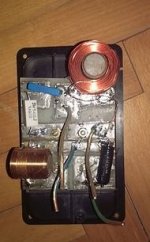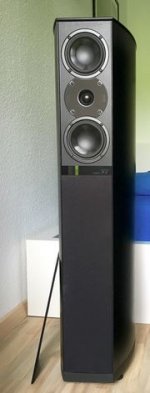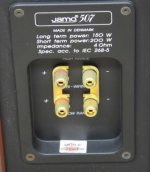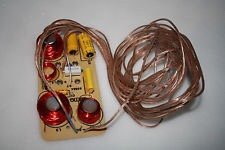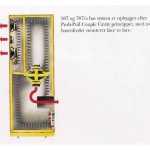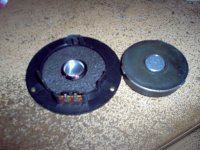I have a pair of Jamo 507 speakers, I have no idea how old they are exactly, my guess is they are about 20 year old.
Long story short, one side sounds more muffled than the other. The twitter doesn't seem completely dead though. I am no expert, does it sound like the crossover need a recap?
The speaker has a twitter, 2 woofers, and 2 subwoofers. It is biampable, 2 of the larger caps looks like they belong to the bass section. That leaves the other 2 caps. 1 is a film cap that says 100V, but does not mention the size, I am guessing I should leave this alone. The other is a 10uF electrolytic cap, does this sound like the problem here?
Or is this how twitter begin to fail? Do they typically just put out less and less sound or do they normally just stop making sound? The front mount of the twitter isn't a normal round shape, I am guessing I will have a hard time finding a twitter that physically would fit in there.
Long story short, one side sounds more muffled than the other. The twitter doesn't seem completely dead though. I am no expert, does it sound like the crossover need a recap?
The speaker has a twitter, 2 woofers, and 2 subwoofers. It is biampable, 2 of the larger caps looks like they belong to the bass section. That leaves the other 2 caps. 1 is a film cap that says 100V, but does not mention the size, I am guessing I should leave this alone. The other is a 10uF electrolytic cap, does this sound like the problem here?
Or is this how twitter begin to fail? Do they typically just put out less and less sound or do they normally just stop making sound? The front mount of the twitter isn't a normal round shape, I am guessing I will have a hard time finding a twitter that physically would fit in there.
Tweeters most commonly fail open circuit meaning no output at all. Film caps should be super reliable and that will be what feeds the tweeter in some form, possibly in conjunction with other parts such as a resistor and perhaps a coil across the tweeter.
So the crossover is the least likely suspect imo at the moment.
Easiest way to prove this is to swap the tweeter with the good one.
So the crossover is the least likely suspect imo at the moment.
Easiest way to prove this is to swap the tweeter with the good one.
Thanks for your reply. I think you are right.
I ran a frequency sweep through both speakers. Not only the high frequency has lower output, the low frequency seems to as well. But I can't be sure because bass frequency is much less directional. Then I run it on this offending speaker alone. It can produce from 40 Hz up to 10+k Hz. So it seems that it can produce all the frequencies, just the amount seems to differ from the other one.
I ran a frequency sweep through both speakers. Not only the high frequency has lower output, the low frequency seems to as well. But I can't be sure because bass frequency is much less directional. Then I run it on this offending speaker alone. It can produce from 40 Hz up to 10+k Hz. So it seems that it can produce all the frequencies, just the amount seems to differ from the other one.
Looks like a film cap on the tweeter to me. The blue thing. Unlikely to go wrong.
I'd take the tweeters out and test them with a 1.5V AA or AAA penlight battery. You'd expect to hear a crackle when applying a voltage. Or look for about 6 ohms continuity with a multimeter.
Sometimes these things have dried up ferrofluid oil which just becomes a solid lump and reduces output too. It's replaceable.
Get your screwdriver out and see how it goes.
I'd take the tweeters out and test them with a 1.5V AA or AAA penlight battery. You'd expect to hear a crackle when applying a voltage. Or look for about 6 ohms continuity with a multimeter.
Sometimes these things have dried up ferrofluid oil which just becomes a solid lump and reduces output too. It's replaceable.
Get your screwdriver out and see how it goes.
Attachments
Thanks for your reply. I think you are right.
I ran a frequency sweep through both speakers. Not only the high frequency has lower output, the low frequency seems to as well. But I can't be sure because bass frequency is much less directional. Then I run it on this offending speaker alone. It can produce from 40 Hz up to 10+k Hz. So it seems that it can produce all the frequencies, just the amount seems to differ from the other one.
One way to be more certain would be to look at the signal across the tweeters with an oscilloscope and compare (be careful of grounding so as not to inadvertently apply a short via any mains grounds).
A less good option would be to use earplugs 😀 and measure on a suitable meter the AC voltage across the tweeter using a test tone. Don't go over a couple volts though.
Since this might be affecting both woofer and tweeter, those nuts on the crossover you can see might have come loose too. I've had that issue.
Looks like a film cap on the tweeter to me. The blue thing. Unlikely to go wrong.
I'd take the tweeters out and test them with a 1.5V AA or AAA penlight battery. You'd expect to hear a crackle when applying a voltage. Or look for about 6 ohms continuity with a multimeter.
Sometimes these things have dried up ferrofluid oil which just becomes a solid lump and reduces output too. It's replaceable.
Get your screwdriver out and see how it goes.
Do you have a Jamo 507 too? My crossover looks different.
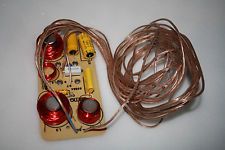
I got this from the net. Mine looks exactly like that, except the colour on the electrolytic caps are different.
I'm pretty sure the tweeter will crackle with battery, it sounds fine as long as I don't compare it to the other one.
And FWIW the Jamo part number for my twitter is 38819. Can't find it on eBay though.
One way to be more certain would be to look at the signal across the tweeters with an oscilloscope and compare (be careful of grounding so as not to inadvertently apply a short via any mains grounds).
A less good option would be to use earplugs 😀 and measure on a suitable meter the AC voltage across the tweeter using a test tone. Don't go over a couple volts though.
I don't have an osciloscope though. May be I didn't use the right term, what I meant by frequency sweep is playing test tones with a computer through a speaker amplifier.
Notorious photobucket wastes our time again! 😕
You can upload a picture of your crossover with the paperclip thingie in this forum after 5 or so posts.
But mainly get stuck in. Visual inspection for lose wires. Try swapping components and channels and see if the fault follows. It's always good to make some notes of what wires go where before disassembling.
The fault could actually be in one channel of the amplifier. A dirty switch or potentiometer would do it.
You can upload a picture of your crossover with the paperclip thingie in this forum after 5 or so posts.
But mainly get stuck in. Visual inspection for lose wires. Try swapping components and channels and see if the fault follows. It's always good to make some notes of what wires go where before disassembling.
The fault could actually be in one channel of the amplifier. A dirty switch or potentiometer would do it.
In my original post, I mentioned the "short story". The long story is that I checked everything from upstream to downstream, and even my room acoustic. Believe me swapping cable off the back of the amplifier is a lot easier than emptying half the furniture of my listening room. 😀
Well, try the simple things then. Swap the speakers round! But mark the allegedly faulty one first. That should eliminate the amp and cabling. 😀
Just for curiosity sake I removed the biamp jumper on the speakers. To my surprise the high frequency posts are only connected to the tweeter. This I could clearly tell one is louder than the other, but both clearly produce sound without audible distortion.
The low frequency posts are connected to the midrange driver and woofer. If I listen to music this way it sounds like grandpa's stereo with the high frequency roll off. I can't detect any unbalance volume. It can produce frequency up to around 11kHz before they become inaudible.
The information on this speaker appear to be scarce, I found a few bits of information, though I have no idea how accurate they are.
impedance: 4 ohms
efficiency: 88 dB/W at 1m
crossover points: 150 and 3000Hz
high frequency crossover capacitor size: 6uF
midrange crossover capacitor size: 10uF
If I can find a tweeter that would be fine, but unlikely IMO. I could try replacing the high frequency portion of the crossover, but it is a longshot. The next option I could see is to try build a tweeter box with a suitable crossover. I have a multi channels receiver that has a function to use its unused channel for biamping, so I could use it to drive this tweeter box.
Any advice to prevent the speakers from going to a landfill is much appreciated.
Edit: Initially I wanted to use the speakers like a passive subwoofer for bookshelf speakers, but found that the low frequency input is tied to the midrange driver as well. It is still possible I guess I build an appropriate crossover.
The low frequency posts are connected to the midrange driver and woofer. If I listen to music this way it sounds like grandpa's stereo with the high frequency roll off. I can't detect any unbalance volume. It can produce frequency up to around 11kHz before they become inaudible.
The information on this speaker appear to be scarce, I found a few bits of information, though I have no idea how accurate they are.
impedance: 4 ohms
efficiency: 88 dB/W at 1m
crossover points: 150 and 3000Hz
high frequency crossover capacitor size: 6uF
midrange crossover capacitor size: 10uF
If I can find a tweeter that would be fine, but unlikely IMO. I could try replacing the high frequency portion of the crossover, but it is a longshot. The next option I could see is to try build a tweeter box with a suitable crossover. I have a multi channels receiver that has a function to use its unused channel for biamping, so I could use it to drive this tweeter box.
Any advice to prevent the speakers from going to a landfill is much appreciated.
Edit: Initially I wanted to use the speakers like a passive subwoofer for bookshelf speakers, but found that the low frequency input is tied to the midrange driver as well. It is still possible I guess I build an appropriate crossover.
Last edited:
Navyblue, this is a reflex MTM with 4" midbass units wired in parallel, I'd guess. Which is a glorified two way. There is no mid and bass. Usual biwire nonsense. It's really only useful for testing tweeter and bass section seperately if you remove the jumpers.
I think you are in a complete muddle here. Sorry. 😀
Let's see this crossover for a start. It's probably mounted on the backplate. Post it to diyaudio. I know how this stuff works.
And I'll tell you what is going on when I see it. I am expecting second order filters between the midbasses and the tweeter.
And I am sure we can fix this. Preferably without resorting to the dubious eBay for an overpriced old replacement tweeter. But it would help to know what the diameter in mm of the tweeter faceplate and baffle cutout is in all likelihood. Maybe even what type it is. Plastic or fabric dome.
I think you are in a complete muddle here. Sorry. 😀
Let's see this crossover for a start. It's probably mounted on the backplate. Post it to diyaudio. I know how this stuff works.
And I'll tell you what is going on when I see it. I am expecting second order filters between the midbasses and the tweeter.
And I am sure we can fix this. Preferably without resorting to the dubious eBay for an overpriced old replacement tweeter. But it would help to know what the diameter in mm of the tweeter faceplate and baffle cutout is in all likelihood. Maybe even what type it is. Plastic or fabric dome.
Attachments
Last edited:
Yes I am no expert, which is why I am asking here. But I don't think you know what is going on either, mostly because you don't read what I already wrote. I already described and posted a photo of the crossover, but you are still telling me where to find it. [emoji4]
This is not a 2 way speaker, it is 3 way. The woofers are in a push pull configuration hidden inside the enclosure, so parallel too.
And no this configuration is not for speaker testing, nor for biwiring. It is for biamping with flea watt tube amp if I were to make an educated guess.
The tweeter is fabric 1".
This is not a 2 way speaker, it is 3 way. The woofers are in a push pull configuration hidden inside the enclosure, so parallel too.
And no this configuration is not for speaker testing, nor for biwiring. It is for biamping with flea watt tube amp if I were to make an educated guess.
The tweeter is fabric 1".
OK, we are making progress. Slowly... 😱
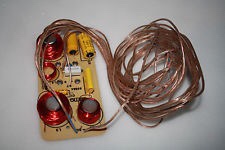
That's too small to see clearly. But I think I am seeing a MKP capacitor on the tweeter circuit. Which is a reliable component. Solder joints would be worth visually inspecting. They can crack.
But the main event is the tweeter section is separately testable because the tweeter crossover is built in. Note the wiring colours before doing this, but if the tweeters are connected with spade connectors, I think you just swap them round and see if the low level fault follows.
It's hard to say how a tweeter can lose level exactly and still work. Maybe a rubbing voicecoil or dried up ferrofluid. If you are very careful, you can often disassemble a tweeter and inspect it.
I asked about the diameter, because it wouldn't be hard to file down a plastic faceplate generic tweeter to fit. You might then need to adjust the value of the white tweeter resistor in the filter for level, which again I wanted to see.
That's too small to see clearly. But I think I am seeing a MKP capacitor on the tweeter circuit. Which is a reliable component. Solder joints would be worth visually inspecting. They can crack.
But the main event is the tweeter section is separately testable because the tweeter crossover is built in. Note the wiring colours before doing this, but if the tweeters are connected with spade connectors, I think you just swap them round and see if the low level fault follows.
It's hard to say how a tweeter can lose level exactly and still work. Maybe a rubbing voicecoil or dried up ferrofluid. If you are very careful, you can often disassemble a tweeter and inspect it.
I asked about the diameter, because it wouldn't be hard to file down a plastic faceplate generic tweeter to fit. You might then need to adjust the value of the white tweeter resistor in the filter for level, which again I wanted to see.
Attachments
Just FYI, the 2 electrolytic caps at the bottom are in parallel.
2 leads at the top marked SQ goes to midrange, same for the 2 leads at the right marked SQ as well.
2 lead in the middle goes to tweeter, one of the marked T.
4 leads at the bottom goes to woofer.
The soldering of the film cap and the resistor looks good, I tugged them and they don't budge.
2 leads at the top marked SQ goes to midrange, same for the 2 leads at the right marked SQ as well.
2 lead in the middle goes to tweeter, one of the marked T.
4 leads at the bottom goes to woofer.
The soldering of the film cap and the resistor looks good, I tugged them and they don't budge.
As it goes, I find that Google seems to even know what colour socks I am wearing today! I don't know how they do it, and couldn't care less. 😀
In these days of social media, none of us are anonymous. 😱
Back on topic, and thanks to Mooly for grasping why I was struggling here, the new crossover image is superb!

Just track back to my suggestions and test that tweeter. Which conveniently is biwireable. It would do no harm to tighten those nuts too. Good electrical contacts help.
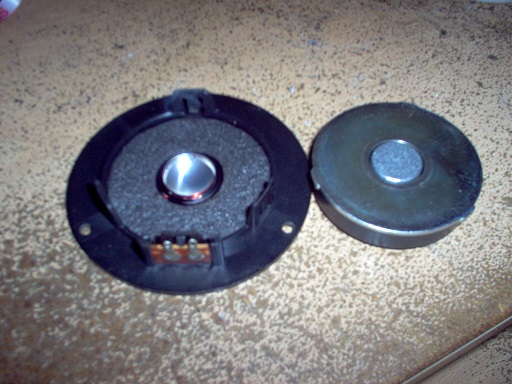
I should mention that ferrofluid is a thin black oil laden with ferric oxide magnetic particles. About 0.1 mL is often put into the narrow tweeter magnetic gap. It allegedly wicks away heat, centres the voicecoil, and damps the Fs resonance of the tweeter. After about 20 years, unfortunately, it turns into thick syrup (resembling Marmite) due to evaporation of the kerosene oil, leaving just the particles which don't help much on their own. It might be the issue, it might not. But there is nothing hard about loudspeakers really. We can fix most stuff. 😀
In these days of social media, none of us are anonymous. 😱
Back on topic, and thanks to Mooly for grasping why I was struggling here, the new crossover image is superb!
Just track back to my suggestions and test that tweeter. Which conveniently is biwireable. It would do no harm to tighten those nuts too. Good electrical contacts help.
I should mention that ferrofluid is a thin black oil laden with ferric oxide magnetic particles. About 0.1 mL is often put into the narrow tweeter magnetic gap. It allegedly wicks away heat, centres the voicecoil, and damps the Fs resonance of the tweeter. After about 20 years, unfortunately, it turns into thick syrup (resembling Marmite) due to evaporation of the kerosene oil, leaving just the particles which don't help much on their own. It might be the issue, it might not. But there is nothing hard about loudspeakers really. We can fix most stuff. 😀
Last edited:
Thanks System7 and Mooly for your inputs, we just solved the case.
I swapped the tweeter of both speakers. The brighter speaker remains the brighter one, which means it's not the tweeter. The tweeter dedicated speaker posts are really useful here.
So the problem is somewhere at the crossover! As for what I can't tell.
I swapped the tweeter of both speakers. The brighter speaker remains the brighter one, which means it's not the tweeter. The tweeter dedicated speaker posts are really useful here.
So the problem is somewhere at the crossover! As for what I can't tell.
- Home
- Loudspeakers
- Multi-Way
- Recap?
